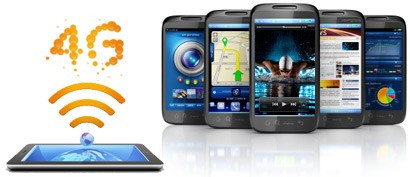4G Focus: What is 4G?

Angola, Armenia, Brazil, Estonia, Kyrgyzstan, Latvia, Lithuania, Moldova, the Philippines and Portugal are just some of the countries that already have a 4G mobile phone network of some description. So with EE launching the UK's first 4G network this week, we look behind the technology and what it means for the UK.
As the name suggests, 4G is the fourth generation of mobile communications standards. It is the successor to the third generation (3G) standards now common in the UK.
A 4G system should provide ultra-fast internet access for smartphones, laptops using USB modems and other mobile devices.
To be classed as 4G the network must be able to provide a theoretical download speed of up to 100Mbps, which is potentially much quicker than the current 3G networks that deliver 'up to' 7.2Mbps.
EE, formerly known as Everything Everywhere - the collaboration between Orange and T-Mobile - puts the theoretical peak speeds for a 4G Long Term Evolution (LTE) service at up to 100Mbps download and 50Mbps upload.
"In reality when there are lots of users on the network, these speeds are not achieved. Real-world speeds for 4G LTE networks vary depending on location, number of users, geography and other factors and are anywhere from 4Mbps to 20Mbps," EE admits.
Different Strokes
Confusingly, there is more than one type of 4G technology: LTE - which is mentioned above - and WiMAX. The latest versions of these technologies are called LTE-Advanced and Mobile WiMAX Release 2.
A number of mobile networks around the world have tried to re-brand their '3.5G' services and call them 4G. However, only LTE and WIMAX are recognised as 4G by the International Telecommunications Union.
Different countries also provide 4G services on a variety of different frequencies, or spectrums. For example the new EE network uses the 1800MHz frequency it previously used for its 2G services.
In the first quarter of 2013, Ofcom will start auctioning off the 800MHz and 2.6GHz spectrums for 4G use by the UK's mobile networks. In comparison, 4G in the US uses the 700MHz and 2100MHz parts of the spectrum.
That means you can't currently buy an iPad 3 in the Apple store in New York and connect at high speed in the UK. Apple was actually told to stop referring to the iPad 3 as a 4G device in the UK.
However the new fourth generation iPad and the iPad mini, going on sale this week, will both support EE's 1800MHz spectrum.
Wide and Fast
Ofcom describes the 800MHz band in the UK as being ideal for widespread mobile coverage. The higher frequency 2.6GHz band is seen as being better for delivering the capacity needed to drive faster speeds.
The other networks don't have enough of the 1800MHz spectrum to cover the majority of the UK, so they will have to wait for the Ofcom auctions before they can launch services of their own.

More widespread Than 3G
The rollout of 4G should at least provide faster mobile broadband to those outside the reach of wired services. For example, fourth generation services offer a possible solution to the challenges of providing decent broadband speeds in rural areas.
As Ofcom's map of services in 2011 shows, 3G failed to penetrate the country as a whole and outside major cities the coverage usually dropped to around 25 percent. Ofcom has promised that 4G high-speed data connections will reach the majority of the population by the end of 2017 at the latest.
In order to implement that, some of the spectrum being auctioned off will carry an obligation to provide mobile broadband access for indoor reception to at least 98 percent of the UK population.
EE however plan a much quicker role out than that. They launched 4G in 11 cities this week, with a further five being added by Christmas. By the end of 2013 it plans on having 60 percent of the UK covered, moving up to 98 percent by the end of 2014.
Freeview Freezeout
One unexpected problem with 4G mobile services is that the signals could interfere with viewers' Freeview TV reception.
The use of airwaves in the 800MHz band that is being transitioned from TV broadcast to mobile services has the potential to affect Freeview receivers designed to accept those airwaves.
EE claims that any impact to services will only happen in certain geographical areas, but this will not occur until 2013 and it cannot predict which areas will be affected.
Ofcom and the government have proposed a new organisation be set up to inform and assist affected viewers and funding has also been pledged to tackle the issue.
© Copyright IBTimes 2025. All rights reserved.





















